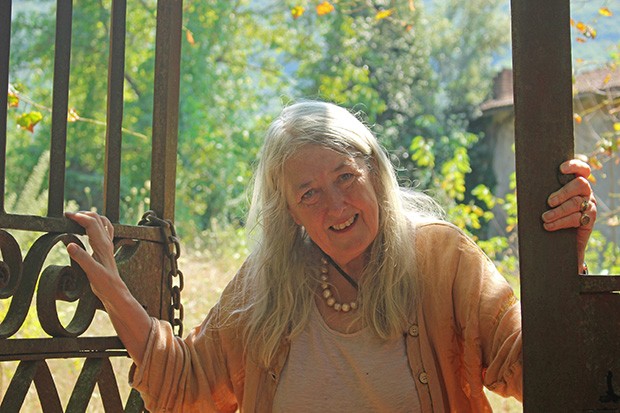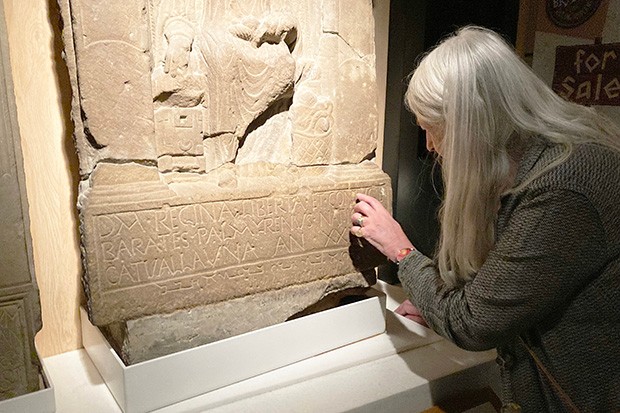Reviving Roman voices: Mary Beard on the remarkable life of one woman
The remarkable story of one Roman woman, pieced together from fragments over many centuries, reveals insights into family life more than 2,000 years ago. Mary Beard gives voice to the long-silent Turia

During the civil wars that tore the Roman Republic in the middle of the first century BC, leading to the birth of the empire, one Roman woman was facing her own crises – both public and private.
Usually known to us as ‘Turia’, she was born into a high-ranking family and by the late 50s BC had become engaged to be married. It was obviously a ‘good match’ with a man of prospects.
But before the wedding could take place, not only had her fiancé suddenly quit Rome to fight under Pompey the Great – in other words, on the losing side in the war against Julius Caesar – but, tragically, her mother and father had also been murdered in their remote house in the country.
Turia moved in with her future mother-in-law, but seems to have been largely left to cope with her problems alone, or with the help of just her sister. She managed to take vengeance on her parents’ murderers and successfully fought off some of her own relations who contested her inheritance. At the same time, she sent supplies to her absent fiancé, selling off some of her own jewellery to do so.
Things looked up, albeit briefly. Although Julius Caesar was victorious in the war against Pompey, he pardoned his enemies and allowed them to return to Rome, so Turia and her fiancé were eventually able to get married. But worse was to come.
Just a few years later, after Caesar’s assassination in 44 BC, the junta who ruled the city put a price on her husband’s head, and he was forced to leave the city again. It was only thanks to Turia’s intervention on his behalf with Lepidus, one of Rome’s so-called ‘ruling three’ (alongside Mark Antony and Octavian, the future emperor Augustus), that he was allowed back – but not before she had been horribly insulted and beaten black and blue by some of the regime’s apparatchiks.
Peace finally came to Rome more than a decade later, under its first emperor, Augustus – who by then had cannily reinvented himself as a responsible elder statesman. The marriage of Turia and her husband lasted 41 years, with only one major disappointment: they did not have any children.
Eventually, in despair, Turia suggested that her husband divorce her, so that she herself could find him another wife who might be able to produce an heir. Her idea seems to have been for a curious ménage à trois in which all their property remained jointly held, managed by her, and they would share the children of the new wife between the three of them.
More like this
But the husband would hear nothing of this scheme. Turia, after all, had remained faithful to him when he was in exile – why would he forsake her now?
Pieces of the puzzle
This is a rare story of a real woman’s life in ancient Rome. We know of it only thanks to the speech of praise given by the husband at Turia’s funeral, which he then had inscribed on two marble panels, almost certainly displayed on the facade of what must have been a vast tomb. All we can say about her comes from there.
We do not know exactly where the monument originally stood, because it was later broken up and the material recycled into other buildings. Fragments of the inscription have been discovered over the past few centuries all across the city: a couple of pieces in a Christian catacomb, one in an abbey wall, another unearthed during works on the sewers near modern Trastevere, yet another languishing unrecognised in a museum storeroom.
Other parts have come down to us only in manuscript copies made in the 17th century, recording fragments of the inscrip- tion that were then known but have since been lost again.
Reconstructing the text and, thus, the story of Turia’s life has been like doing a giant jigsaw puzzle. We have so far – there may be more pieces to come, if we are lucky – discovered slightly more than half of what was once written. The original text ran to almost 200 lines, covering the panels that were originally 2.5 metres tall and just under 1 metre wide – making it the longest Latin inscription created by a private individual to have survived anywhere in the Roman world.
Sadly, missing elements include the actual names of the couple, both husband and wife. ‘Turia’ is a conjecture by an 18th-century antiquarian. It is almost certainly wrong, but the name has stuck – and the whole document is generally known as the Laudatio Turiae, or Praise of Turia.
Of course, none of this gives us the woman’s own view of her life. What we have is what the husband chose to say about Turia at her funeral, and how he chose to have her permanently commemorated on the tomb, which he no doubt paid for. It was almost bound to be laudatory: funeral speeches, then as now, are not the place for criticism and complaint.
As well as the more striking and unusual episodes in her life mentioned above, there is plenty of praise for the stereotypical qualities that were the clichés of Roman womanhood – the kind of thing that almost any Roman husband would have wanted to be said about his wife.
“Why should I list your private qualities?” he remarks at one point: “Your modesty, your obedience, your kindness, your good nature, your devotion to weaving, your honouring of the gods without a trace of superstition, your inconspicuous dress, your restrained appearance.”
Taking the initiative
All this is very much in line with another famous Roman tombstone made a few hundred years earlier, which summed up the qualities of another dead woman more succinctly: “She was charming in her conversation, elegant in her bearing. She kept house; she wove wool.” The same sentiments can be found on many more memorials erected from one end of the Roman empire to the other.
But even if the Praise of Turia doesn’t give us Turia’s own perspective, some parts of it do challenge the standard view of how a woman in ancient Rome was supposed to behave. The scheming exploits of such larger-than-life characters as Augustus’s wife Livia are one thing, memorably reimagined in Robert Graves’ 1934 novel I, Claudius and probably fictional.
But here is a rich but relatively ordinary woman who is actually praised for taking the initiative, in the public world, to bring the murderers of her parents to justice. (That crime alone is a chilling glimpse of the lawlessness of Italy at the period – though, to be fair, we don’t know anything of the circumstances of the crime or of its perpetrators: gangland brigands, exploited servants or those with a private grudge?) And she receives even more praise for taking on her own relatives in the inher- itance dispute, then pleading in person for her own husband’s return before one of the junta – even getting beaten up in the process.
How typical was this? We cannot be sure. In one famous case, a female orator of the same period, Hortensia, is said to have addressed the junta publicly to protest against a tax imposed on women’s wealth during the civil wars after Caesar’s assassination. She was partially successful, and the number of women liable to the tax was reduced.
In these cases involving Hortensia and Turia, though, such an act was probably very much a wartime phenomenon. It is quite common, even in societies where women are usually confined to the home, for women to take the initiative or be forced into the limelight in periods of crisis, especially when men are absent on campaign.
That power does not usually last: for example, most of the women in Britain who found jobs driving buses or lorries during the Second World War lost them again in peacetime. So too, Turia – after filling the power vacuum while her husband was fighting overseas or was in exile – almost certainly returned to domes- ticity when ‘normality’ was restored.
And there are all kinds of puzzles about the story told in the Praise of Turia that go far beyond the tantalising anonymity of the couple concerned.
It is not clear, for example, how she took ‘vengeance’ (or secured ‘justice’ – the exact word is lost from the stone) for the murder of her parents. It is hard to imagine, bearing in mind Roman rules, that she stood up and publicly pleaded in a courtroom – though that is close to what Hortensia did.
Maybe it was something much closer to paying a private hit squad: that was probably how, in practice, most Roman disputes and vendettas were settled. Despite the fame of Roman law, such ‘self-help’, as it might euphemistically be called, would have been more common.
For me the most puzzling and memorable part of the Praise is the section on the couple’s infertility. It is no surprise that the husband puts that down entirely to his wife. Most Roman men assumed that, if a couple failed to have a baby, it was due to some deficiency in the woman, not the man. But why did he make such an issue of it in his speech, with all the details of the proposed divorce and ménage à trois? Rather than sheer clumsiness, it was very likely a sign of the times.
Augustus was still on the throne when Turia died. As part of his personal reinvention from bellicose warlord to elder states- man, he placed enormous emphasis on promoting the family and the Roman birth rate, and gave specific financial and legal privileges to those with at least three children.
Augustus, in other words, made this ‘private’ aspect of domestic life part of ‘public’ business. And that is what we see reflected here – as well as the husband’s implication, in refusing the divorce, that his love for Turia surpassed any such state pressure.
Being Roman
Turia is just one of the characters we spotlight in a series of six BBC Radio 4 programmes and podcasts that explore what it was to be Roman. In them, we look far beyond the standard image of upper-class men in togas or battledress spouting Latin.
To be fair, we do include one of those – the emperor Marcus Aurelius (reigned AD 161–180). But we give more time to the little-known surviving letters between him and his tutor, Marcus Cornelius Fronto, than to his better-known Meditations – still bestsellers among well-being handbooks after almost 2,000 years.
However, we range much more widely across the population of the Roman empire. In one programme we meet Galen, a celebrity doctor of the second century AD. He’s not really a household name today, yet we can still read more than 3 million words he wrote on medicine, philosophy and himself.
Another introduces a young boy by the name of Quintus Sulpicius Maximus, who died when he was only 11 years old – though not before he had won a ‘highly commended’ prize in an international poetry competition. His parents had his poem inscribed alongside his portrait on his tombstone.
Then there is Regina (‘Queenie’), a girl who was originally from somewhere near St Albans. Enslaved and later freed, she then married her former master, who was a Syrian from Palymra. The pair lived and died near Hadrian’s Wall in a textbook example of diversity, Roman-style – one of many that reveal how people from all across the Roman world mingled and interacted.

But perhaps my favourite of the six is a long-suffering and slightly bad-tempered middle manager from Roman Egypt. He usually refers to himself only by his job title: strategos (assistant governor). But a series of his letters, preserved on papyrus, allows us to trace the problems he encountered while attempting to organise a visit to Egypt by the emperor Diocletian in the late third century AD. Local mayors proved decidedly uncooperative: “I have told you two or three times,” he writes to one of them, “to get the bakery repaired so we can feed his majesty’s soldiers.”
He also had to cover his back with his own superiors, reporting that: “I have told them that they have to get the bakery repaired.” His letters provide a wonderful glimpse into a Roman office and a Roman filing cabinet over a couple of weeks in AD 298 – and into the burden placed on the locals ahead of “the auspiciously impending visit of our ruler”, as the strategos puts it in his formal bureaucratese. It all makes a visit from King Charles and Queen Camilla look quite low maintenance.
Scattered evidence
One of our aims in the series is to show just how varied the ‘Romans’ were. But we also look to lift the lid on some of the surprising stories of rediscovery that have allowed us to get to know these ancient characters.
The tombstone of little Quintus Sulpicius Maximus, for instance, was discovered only after Garibaldi’s forces destroyed Rome’s ancient wall after capturing the city in 1870: it had been recycled as a building block in the defences just a couple of hundred years after the boy’s death.
Some of Galen’s works, meanwhile, are known only in Arabic versions: his medical writings were influential in the Arab world, and some translations have been preserved in Arabic long after the original Greek texts were lost.
The letters between Fronto and Marcus Aurelius were rediscovered in even stranger circumstances. The parchment on which a copy of them had once been transcribed was later washed down and, for the sake of economy, reused by some monks in the seventh century to record the minutes of an early Christian council.
The more ancient correspondence would have disappeared forever, had an ingenious 19th-century scholar not realised that an earlier text lay underneath the Christian minutes, and used a chemical compound to reveal the traces.
The fate of the stone on which the Praise of Turia was inscribed – smashed up and scattered across Rome, only to be rediscovered in sewerage works and abbey walls, then pieced together again – is therefore not as unusual as it might at first seem.
It is a perfect reminder not only of how fragile the evidence from the Roman past can be, but also of how chance and serendipity can sometimes still bring that past back to us, with all those stories of real Romans and their real lives. Long may that serendipity continue.
- On the podcast | How brutal were Roman emperors?
Mary Beard is honorary fellow at Newnham College, University of Cambridge, and an author and broadcaster. Her new book, Emperor of Rome, is out now from Profile Books.
Authors

Start the year with a subscription to BBC History Magazine - £5 for your first 5 issues!
As a print subscriber you also get FREE membership to HistoryExtra.com worth £34.99 + 50% London Art Fair 2024 Tickets




